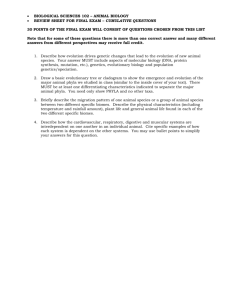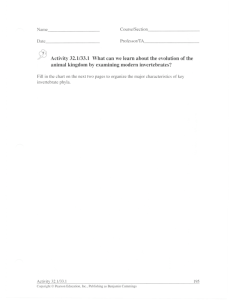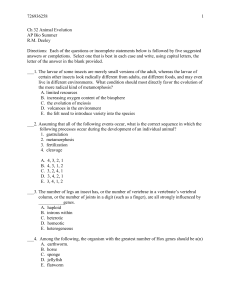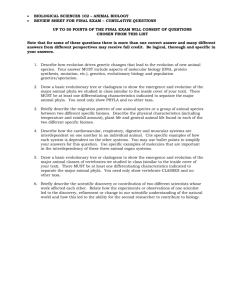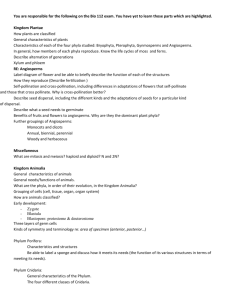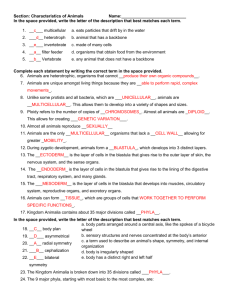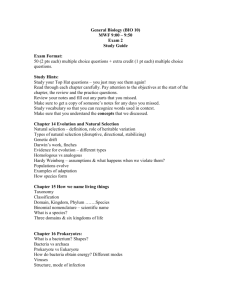Pseudocoelomates: Phyla Nematoda & Rotifera
advertisement
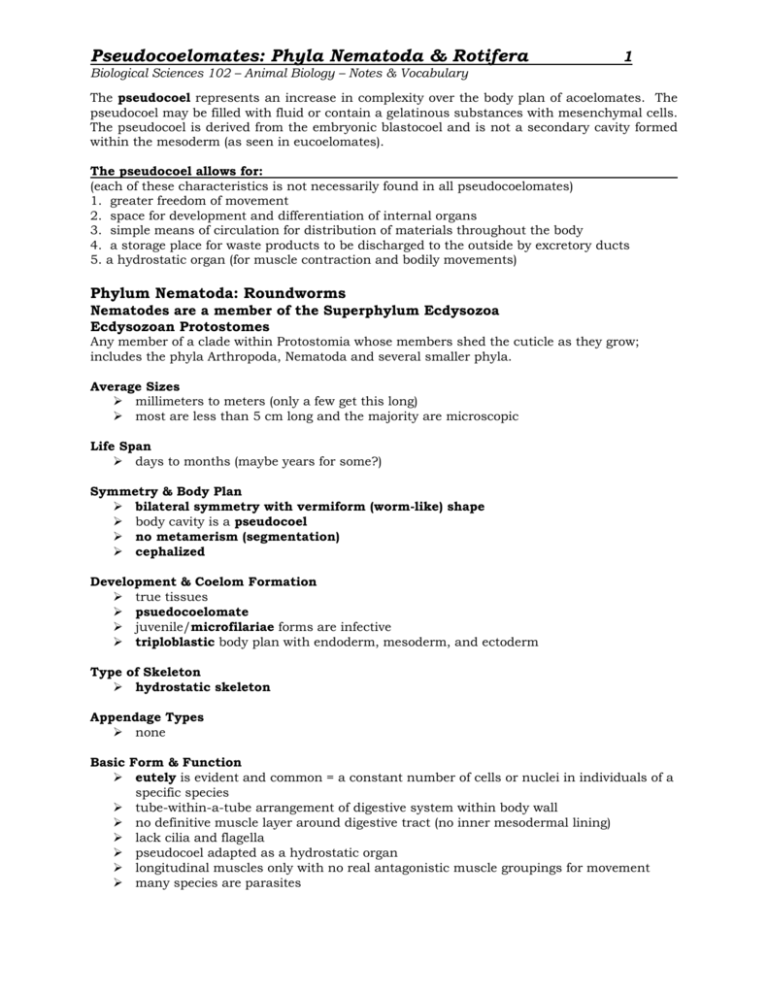
Pseudocoelomates: Phyla Nematoda & Rotifera 1 Biological Sciences 102 – Animal Biology – Notes & Vocabulary The pseudocoel represents an increase in complexity over the body plan of acoelomates. The pseudocoel may be filled with fluid or contain a gelatinous substances with mesenchymal cells. The pseudocoel is derived from the embryonic blastocoel and is not a secondary cavity formed within the mesoderm (as seen in eucoelomates). The pseudocoel allows for: (each of these characteristics is not necessarily found in all pseudocoelomates) 1. greater freedom of movement 2. space for development and differentiation of internal organs 3. simple means of circulation for distribution of materials throughout the body 4. a storage place for waste products to be discharged to the outside by excretory ducts 5. a hydrostatic organ (for muscle contraction and bodily movements) Phylum Nematoda: Roundworms Nematodes are a member of the Superphylum Ecdysozoa Ecdysozoan Protostomes Any member of a clade within Protostomia whose members shed the cuticle as they grow; includes the phyla Arthropoda, Nematoda and several smaller phyla. Average Sizes ¾ millimeters to meters (only a few get this long) ¾ most are less than 5 cm long and the majority are microscopic Life Span ¾ days to months (maybe years for some?) Symmetry & Body Plan ¾ bilateral symmetry with vermiform (worm-like) shape ¾ body cavity is a pseudocoel ¾ no metamerism (segmentation) ¾ cephalized Development & Coelom Formation ¾ true tissues ¾ psuedocoelomate ¾ juvenile/microfilariae forms are infective ¾ triploblastic body plan with endoderm, mesoderm, and ectoderm Type of Skeleton ¾ hydrostatic skeleton Appendage Types ¾ none Basic Form & Function ¾ eutely is evident and common = a constant number of cells or nuclei in individuals of a specific species ¾ tube-within-a-tube arrangement of digestive system within body wall ¾ no definitive muscle layer around digestive tract (no inner mesodermal lining) ¾ lack cilia and flagella ¾ pseudocoel adapted as a hydrostatic organ ¾ longitudinal muscles only with no real antagonistic muscle groupings for movement ¾ many species are parasites Pseudocoelomates: Phyla Nematoda & Rotifera 2 Biological Sciences 102 – Animal Biology – Notes & Vocabulary Specialized Cell Types/Organs ¾ amphids = sensory organs of the head; reduced or absent in many parasitic forms ¾ phasmids = sensory organs near the posterior end “Organ Systems” Integumentary System (skin) ¾ syncitial or cellular epidermis ¾ thickened, non-living cuticle that is sometimes molted ¾ cilia absent Muscular System ¾ only longitudinal muscle fibers in body wall; no circular muscles ¾ no antagonistic muscles groups for movement Circulatory System ¾ none – nutrient/waste removal by diffusion/osmosis/cell transport (phagocytosis/pinocytosis) Respiratory System (gas exchange) ¾ none – gas exchange by simple diffusion = cutaneous respiration Nervous System ¾ cerebral ganglia or nerve ring connected to anterior and posterior nerves Sensory Organs ¾ amphids and phasmids connected to ciliated pits ¾ some have eyespots Digestive System (food/water supply) ¾ complete digestive system with mouth and anus ¾ well muscularized pharynx ¾ no definitive muscle layer around digestive tract (no inner mesodermal lining in pseudocoelomates) ¾ free living forms feed on bacteria, yeasts, fungi and algae ¾ some nematodes are predators on rotifers, tardigrades, small annelids and other nematodes ¾ many parasitic forms feeding on plant and animal tissues and fluids Immune System ¾ none (?) Excretory System (waste removal) ¾ system of canals and protonephridia in some pseduocoelomates, but not in nematodes ¾ cloaca in some pseudocoelomates = opening that receives excretory, digestive and reproductive products present in some Reproduction ¾ single or double set of gonads and ducts in each sex ¾ sexes nearly always separate (dioecious) with males usually smaller than females ¾ eggs may have chitinous shell ¾ eutely is evident and common = a constant number of cells or nuclei in individuals of a specific species ¾ cleavage is mostly mosaic Pseudocoelomates: Phyla Nematoda & Rotifera 3 Biological Sciences 102 – Animal Biology – Notes & Vocabulary Mechanism/Mode of Locomotion ¾ contraction of longitudinal muscles against pseudocoel (hydrostatic organ) Specialized Defenses/Toxin/Poisons ¾ tissue or organ damage by parasitic forms, but not necessarily due to a toxin Ecology & Adaptive Radiation ¾ marine, freshwater, terrestrial (soil) from polar regions to the topics ¾ from high mountains to deep seas ¾ nearly every type of animal and plant can be parasitized by nematodes Social Organization ¾ none Communication ¾ none(?) Thermoregulation ¾ none Common Nematode Parasites (see table 15.1 in text) ¾ Hookworm ¾ Pinworm ¾ Intestinal roundworm ¾ Trichina worm ¾ Whipworm Phylum Rotifera: Rotifers Rotifers are a member of the Superphylum Lophotrochozoa Lophotrochozoan Protostomes Any member of a clade within Protostomia whose members generally possess either a trochophore larva or a lophophore; includes the phyla Annelida, Mollusca and the ectoprocts Average Sizes ¾ Microscopic; micrometers to a few millimeters Life Span ¾ days (a few years in dessicated form) Symmetry & Body Plan ¾ bilateral symmetry ¾ body cavity is a pseudocoel ¾ no metamerism (segmentation) ¾ cephalized Development & Coelom Formation ¾ true tissues ¾ psuedocoelomate ¾ triploblastic body plan with endoderm, mesoderm, and ectoderm Type of Skeleton ¾ hydrostatic skeleton Pseudocoelomates: Phyla Nematoda & Rotifera 4 Biological Sciences 102 – Animal Biology – Notes & Vocabulary Appendage Types ¾ none Basic Form & Function ¾ can be sessile, floaters, creepers or swimmers ¾ elongated or saclike body plan with head at one end and foot at other with one to four toes ¾ cilia form a corona around the mouth ¾ cilia used for both locomotion and feeding ¾ eutely is evident and common = a constant number of cells or nuclei in individuals of a specific species; most structures in rotifers are syncitial Specialized Cell Types/Organs ¾ corona of cilia around the mouth ¾ mastax = muscular pharynx ¾ pedal glands of foot secrete adhesive material in both sessile and creeping forms “Organ Systems” Integumentary System (skin) ¾ syncitial epidermis ¾ some have a secreted cuticle; others have a fibrous layer to epidermis Muscular System ¾ subepidermal muscles some of which are longitudinal and some circular Circulatory System ¾ none – nutrient/waste removal by diffusion/osmosis/cell transport (phagocytosis/pinocytosis) Respiratory System (gas exchange) ¾ none – gas exchange by simple diffusion = cutaneous respiration Nervous System ¾ bilobed “brain” with paired nerves running to internal organs Sensory Organs ¾ sensory antennae on trunk ¾ eyespots on head Digestive System (food/water supply) ¾ complete digestive system with mouth and anus ¾ well muscularized pharynx = mastax that contains trophi (jaws) for sucking and grinding food particles ¾ ciliated corona helps sweep food particles to mouth ¾ feed on minute organic particles or algae ¾ carnivorous forms feed on protozoa and small metazoans; some hunter types have trophy they can project to capture food; trappers have a funnel shaped area around the mouth Immune System ¾ none (?) Pseudocoelomates: Phyla Nematoda & Rotifera 5 Biological Sciences 102 – Animal Biology – Notes & Vocabulary Excretory System (waste removal) ¾ pair of protonephridial tubules with flame cells that empty into a common cloacal bladder ¾ cloaca in some pseudocoelomates = opening that receives excretory, digestive and reproductive products present in some ¾ protonephridia play an important role in osmoregulation Reproduction ¾ single (male) or double set of gonads (female) and ducts in each sex ¾ sexes separate (dioecious) ¾ males unknown in class Bdelloidea and only occur a few weeks a years in the class Monogononta ¾ all females are parthenogenetic in the class Bdelloidea (diploid females produce diploid females) ¾ parthenogenesis = unisexual reproduction involving the production of young by females that are not fertilized by males; common in rotifers, aphids, bees, ants and wasps. Parthenogenetic eggs may be haploid or diploid. ¾ In the class Monogononta, most of the year diploid females produce thin shelled diploid amictic eggs. These amictic eggs develop parthenogenetically into diploid (amictic) females. When the environment in the pond or stream changes due to crowding, diet, change in photoperiod, etc. some amictic eggs develop into diploid mictic females that produce thin shelled haploid eggs. If these eggs are not fertilized then they will develop into haploid males. If the eggs are fertilized, they become mictic eggs with a thick, resistant shell and become dormant. These “winter eggs” can survive until the environment becomes more suitable at which time they hatch and develop into amictic females (completing the cycle). Females grow and reach maturity in a few days while males rarely grow and are mature at birth. Mechanism/Mode of Locomotion ¾ contraction of longitudinal and circular muscles against pseudocoel (hydrostatic organ) Specialized Defenses/Toxin/Poisons ¾ none (?) Ecology & Adaptive Radiation ¾ most freshwater, a few marine, some are terrestrial ¾ some are parasitic ¾ most are benthic in freshwater lakes and ponds ¾ many species can survive for long periods when desiccated (look like grains of sand) and can tolerate extreme environmental conditions Social Organization ¾ none Communication ¾ none (?) Thermoregulation ¾ none
